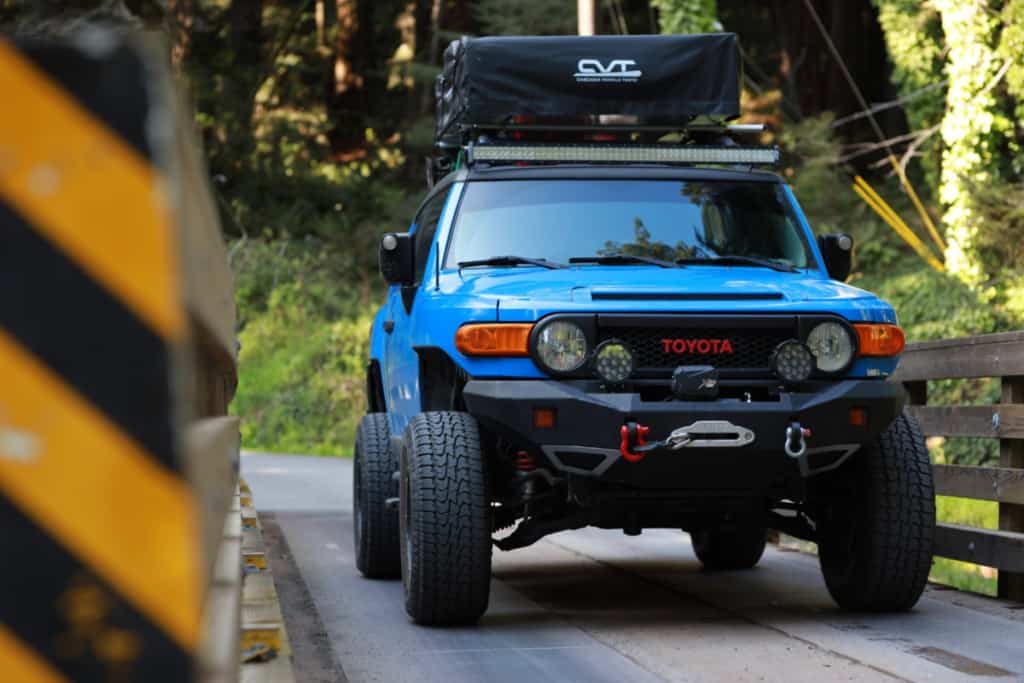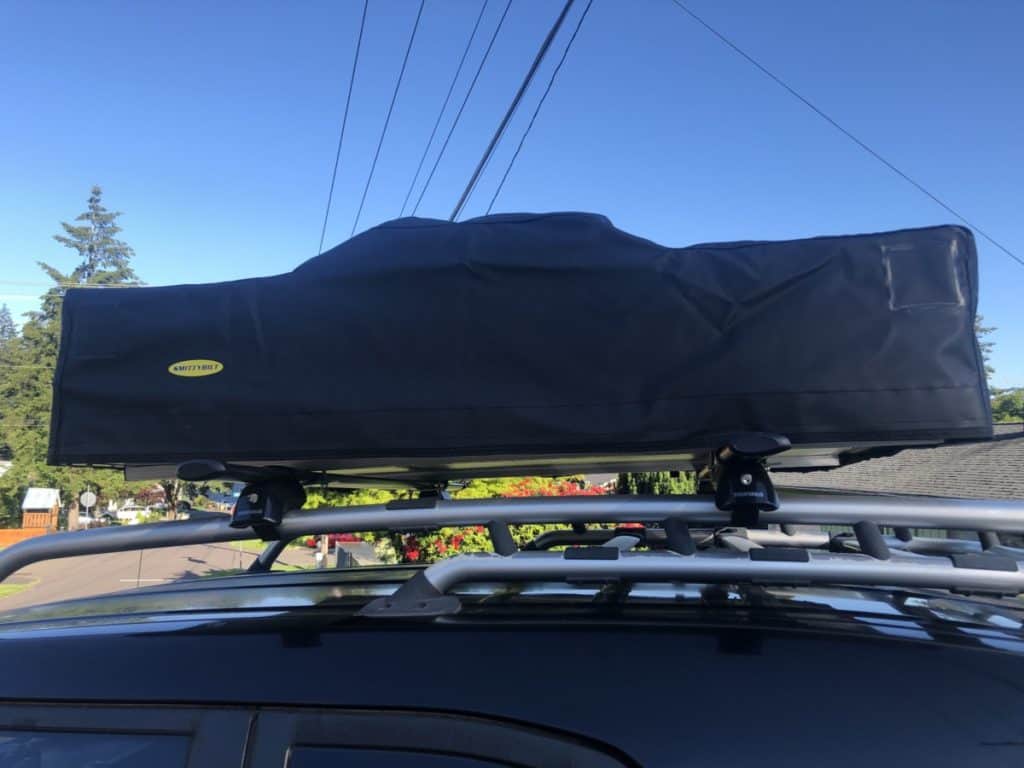
If you’ve ever been in or seen a roof top tent you know they aren’t nearly as large as a ground tent. There isn’t a roof top tent that you can stand and walk around in, but it is still important to be able to sit upright and be comfortable inside the tent.
They can also be rather tall when closed as they sit on top of your roof. This can be a downside because it will create more drag as you drive, in turn making your vehicles fuel efficiency worse. Minimizing the height of your roof rack and roof top tent will decrease wind resistance and theoretically improve gas mileage.
The average height of a softshell roof top tent when open is 48.25″ and 12.95″ when closed. While a hardshell roof top tent averages 42.97″ in height when open and 9.1″ when closed.
These numbers can vary dramatically depending on the style of the tent you have. Hardshell and softshell roof top tents (RTTs) are completely different when it comes to their design, so the averages for their height can differ quite a bit.
Since there is not a one size fits all answer to this question, I have made an easy to read table that compares the heights of 20 well-known RTT models (10 softshell and 10 hardshell) which can answer this question best. I then go on to take the averages of all 20 RTTs and put them in a separate table to compare the two styles.
Comparing 20 Roof Top Tent Height Measurements
Here is a table of twenty very popular softshell and hardshell RTTs showcasing their height in inches when closed and open.
| Roof Top Tent | Style | Height Open | Height Closed |
| Smittybilt Overlander | Softshell | 51″ | 13″ |
| Tepui Low-Pro 2 | Softshell | 44″ | 7″ (slim-side) and 10″ (thick-side) |
| CVT Mount Shasta | Softshell | 50″ | 15.5″ |
| Tepui Ayer 2 | Softshell | 39″ | 11″ |
| FSR High Country | Softshell | 46″ | 14″ |
| Tepui Kukenam | Softshell | 52″ | 12″ |
| CVT Mount Denali | Softshell | 50″ | 15.5″ |
| Wanaka Guana | Softshell | 49.5″ | 12″ |
| TuffStuff Ranger Overland | Softshell | 52″ | 15″ |
| iKamper X Cover | Softshell | 49″ | 13″ |
| Roofnest Sparrow | Hardshell | 40″ | 11″ |
| iKamper Skycamp 2X | Hardshell | 43″ | 12.5″ |
| Alu-Cab Gen 3 | Hardshell | 63″ (internal) | 8.25″ front and 11″ back |
| Roofnest Falcon | Hardshell | 60″ (max) | 7″ |
| Eezi-Awn Stealth | Hardshell | 17″ (front) 56″ (back) | 6.5″ front and 12″ |
| Roost Explorer | Hardshell | 59″ (max) | 5″ front and 13″ back |
| Tepui Hybox | Hardshell | 42.75″ | 12.75″ |
| FSR Odyssey | Hardshell | 43″ | 7.1″ |
| James Baroud Grand Raid | Hardshell | 41.1″ | 13.2″ |
| Skycamp Mini | Hardshell | 48″ | 12.5″ |
A pop-up RTT usually has the least amount of headroom but over the years brands have made this a priority to fix. Foldout RTTs have a solid amount of headroom, especially in the apex of the tent.
On the other hand, overall a hardshell RTT is much more slim when shut. This is huge for aerodynamics and reducing drag when driving. To be honest, I also think they look much cooler too!
Now let’s take a look at the averages from all of these RTTs heights to make some more sense of this data!
Average Roof Top Tent Height
| Average | Height (inches) |
| Softshell Open (AVG) | 48.25″ |
| Softshell Closed (AVG) | 12.95″ |
| *Hardshell Open (AVG) | 42.97″ |
| Hardshell Closed (AVG) | 9.1″ |
| Total Open (AVG) | 45.61″ |
| Total Closed (AVG) | 11″ |
The average height of a roof top tent open is 45.61″ and 11″ when closed.
While this data is helpful, there are some flaws with it. Four of the hardshell RTTs are a clamshell-style that has no single height you could measure.
At their max, the headroom is insanely large and it slowly decreases as you move towards the edge of the tent. I left those tents out of the average total since they are outliers.
For RTTs with different heights in the front and back, I simply used the average of those two measurements. I then took the average for softshells and hardshells separately.
Which roof top tent style is tallest (and shortest)?
Generally speaking, if I were 6’4″ and needed plenty of headroom inside the tent I would recommend buying a clamshell RTT. At their max height, they reach around 60″ by the entrance of the tent. This will give you the most room to sit up and feel comfortable while inside.
After that, I would recommend a softshell RTT. The fold-out design offers a solid amount of headroom especially near the apex of the tent. I have a foldout RTT, am six feet tall, and have plenty of headroom in ours!
Last but not least is the classic pop-up RTT style. While it is very slim and looks great closed, it will typically offer you the least amount of headroom. Some are extremely short at just 40″ in height.
So, if you’re on the taller side and want to sit upright inside your tent I would look for a model with more headroom. It is NOT comfortable slouching will you try to relax inside your RTT.
As I said previously if you’re more concerned about your RTT being as slim as possible while shut, then I would opt for a hardshell model without a doubt. Almost all hardshells will be thinner than a softshell model.
How tall is a roof top tent on top of a car?
This will obviously vary from owner to owner depending on the height of their vehicle and roof rack. If you have a truck and mount the RTT in the bed, it will sit much lower than a lifted Jeep or 4Runner.
Our Fj Cruiser sits very high and the rack is also ridiculously tall. Measuring from the ground to the very top of the tent it sits at 104″ (8.6 feet).

As you can see, the RTT sits a few inches higher than we would ideally want it to. Since this is the hand we were dealt, I didn’t feel it would be worth thousands of dollars to make it lower to the roof.
In no way is our set up the most aerodynamic, and we pay the price with the frequent trips to the gas station.
If you haven’t bought a rack system yet or simply want to see which are some of the best, I highly recommend checking out my article on Choosing a Rack System for a RTT. I give plenty of examples with some of the best racks, what I use, and what might be best for your set up.
Gas Mileage with a Roof Top Tent
There are a handful of steps you can take to try and improve your vehicle’s fuel economy with a RTT mounted to it.
Buying a hardshell RTT will make the biggest difference. Almost all of them are designed to be aerodynamic. Even if they aren’t, it is likely much slimmer than a softshell RTT which averages almost four inches thicker when closed shut.
If you want to learn more on How To Prevent Fuel Loss with a RTT, reading this article will show you a quick list of all of the things you can do without breaking the bank.
Wrapping Up
The height of a RTT will vary a good amount, especially if it is between a softshell or hardshell. If you want the slimmest RTT possible, going with a hardshell is by far the best move. But if you want the most room inside the tent, then a softshell is the right pick.
If you’re curious about some of the items I use for my RTT and camping adventures, check out our recommended gear page. I hope you found the table easy to understand and more importantly, helpful.
This information should serve as a great basis for helping people understand which RTTs are slimmer, as well as what that means to you as a user.
Ultimately, you want to be as comfortable as possible when camping. RTTs do an amazing job of that. But if you’re tall, you may need to make extra considerations for head room!
